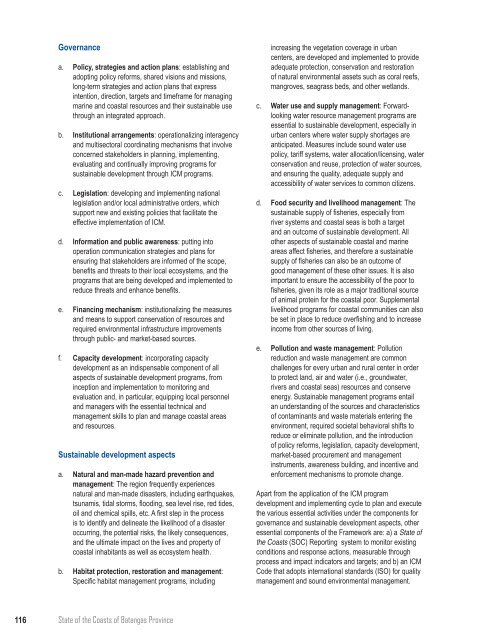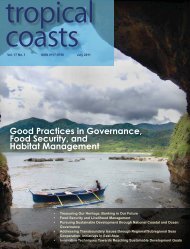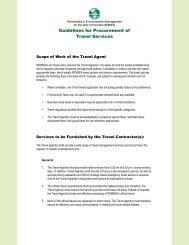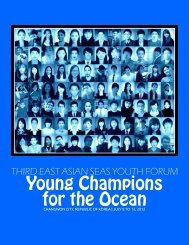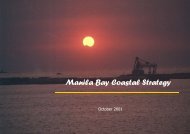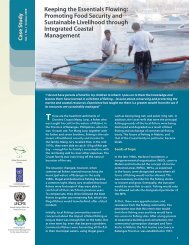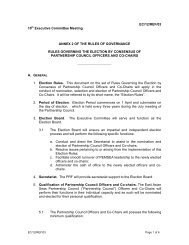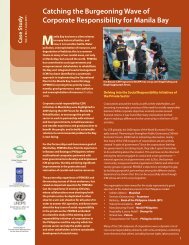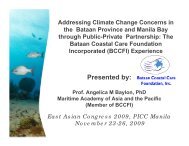Download PDF Copy - Pemsea
Download PDF Copy - Pemsea
Download PDF Copy - Pemsea
Create successful ePaper yourself
Turn your PDF publications into a flip-book with our unique Google optimized e-Paper software.
Governance<br />
a. Policy, strategies and action plans: establishing and<br />
adopting policy reforms, shared visions and missions,<br />
long-term strategies and action plans that express<br />
intention, direction, targets and timeframe for managing<br />
marine and coastal resources and their sustainable use<br />
through an integrated approach.<br />
b. Institutional arrangements: operationalizing interagency<br />
and multisectoral coordinating mechanisms that involve<br />
concerned stakeholders in planning, implementing,<br />
evaluating and continually improving programs for<br />
sustainable development through ICM programs.<br />
c. Legislation: developing and implementing national<br />
legislation and/or local administrative orders, which<br />
support new and existing policies that facilitate the<br />
effective implementation of ICM.<br />
d. Information and public awareness: putting into<br />
operation communication strategies and plans for<br />
ensuring that stakeholders are informed of the scope,<br />
benefits and threats to their local ecosystems, and the<br />
programs that are being developed and implemented to<br />
reduce threats and enhance benefits.<br />
e. Financing mechanism: institutionalizing the measures<br />
and means to support conservation of resources and<br />
required environmental infrastructure improvements<br />
through public- and market-based sources.<br />
f. Capacity development: incorporating capacity<br />
development as an indispensable component of all<br />
aspects of sustainable development programs, from<br />
inception and implementation to monitoring and<br />
evaluation and, in particular, equipping local personnel<br />
and managers with the essential technical and<br />
management skills to plan and manage coastal areas<br />
and resources.<br />
Sustainable development aspects<br />
a. Natural and man-made hazard prevention and<br />
management: The region frequently experiences<br />
natural and man-made disasters, including earthquakes,<br />
tsunamis, tidal storms, flooding, sea level rise, red tides,<br />
oil and chemical spills, etc. A first step in the process<br />
is to identify and delineate the likelihood of a disaster<br />
occurring, the potential risks, the likely consequences,<br />
and the ultimate impact on the lives and property of<br />
coastal inhabitants as well as ecosystem health.<br />
b. Habitat protection, restoration and management:<br />
Specific habitat management programs, including<br />
increasing the vegetation coverage in urban<br />
centers, are developed and implemented to provide<br />
adequate protection, conservation and restoration<br />
of natural environmental assets such as coral reefs,<br />
mangroves, seagrass beds, and other wetlands.<br />
c. Water use and supply management: Forwardlooking<br />
water resource management programs are<br />
essential to sustainable development, especially in<br />
urban centers where water supply shortages are<br />
anticipated. Measures include sound water use<br />
policy, tariff systems, water allocation/licensing, water<br />
conservation and reuse, protection of water sources,<br />
and ensuring the quality, adequate supply and<br />
accessibility of water services to common citizens.<br />
d. Food security and livelihood management: The<br />
sustainable supply of fisheries, especially from<br />
river systems and coastal seas is both a target<br />
and an outcome of sustainable development. All<br />
other aspects of sustainable coastal and marine<br />
areas affect fisheries, and therefore a sustainable<br />
supply of fisheries can also be an outcome of<br />
good management of these other issues. It is also<br />
important to ensure the accessibility of the poor to<br />
fisheries, given its role as a major traditional source<br />
of animal protein for the coastal poor. Supplemental<br />
livelihood programs for coastal communities can also<br />
be set in place to reduce overfishing and to increase<br />
income from other sources of living.<br />
e. Pollution and waste management: Pollution<br />
reduction and waste management are common<br />
challenges for every urban and rural center in order<br />
to protect land, air and water (i.e., groundwater,<br />
rivers and coastal seas) resources and conserve<br />
energy. Sustainable management programs entail<br />
an understanding of the sources and characteristics<br />
of contaminants and waste materials entering the<br />
environment, required societal behavioral shifts to<br />
reduce or eliminate pollution, and the introduction<br />
of policy reforms, legislation, capacity development,<br />
market-based procurement and management<br />
instruments, awareness building, and incentive and<br />
enforcement mechanisms to promote change.<br />
Apart from the application of the ICM program<br />
development and implementing cycle to plan and execute<br />
the various essential activities under the components for<br />
governance and sustainable development aspects, other<br />
essential components of the Framework are: a) a State of<br />
the Coasts (SOC) Reporting system to monitor existing<br />
conditions and response actions, measurable through<br />
process and impact indicators and targets; and b) an ICM<br />
Code that adopts international standards (ISO) for quality<br />
management and sound environmental management.<br />
116 State of the Coasts of Batangas Province


